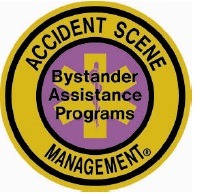 I attended “A Crash Course for the Motorcyclist” along with seventeen other riders. The class was taught by Vicki Sanfelipo and Chris Hawver. The class is their 100 level course and a basic introduction to the material. The class was 8 hours. The class does not teach you how to be a professional first responder like the police or paramedics, but it does make you an educated bystander. From their website:
I attended “A Crash Course for the Motorcyclist” along with seventeen other riders. The class was taught by Vicki Sanfelipo and Chris Hawver. The class is their 100 level course and a basic introduction to the material. The class was 8 hours. The class does not teach you how to be a professional first responder like the police or paramedics, but it does make you an educated bystander. From their website: “Learn what to do in the first 5-30 minutes after a crash until professional help arrives. Helmet removal, jaw thrust, and moving the injured are all addressed & practiced”Accident Scene Management, Inc (ASMI) is a non-profit 501.3c organization, and has trained over 130 instructors and over 16,000 people since it was founded by Vicki Sanfelipo in 1996. Vicki is a registered nurse (RN) and an emergency medical technician (EMT). Vicki works as a nurse at a Milwaukee, Wisconsin hospital and is the program director for ASMI.
The course really focused on training motorcyclists to effectively respond to a motorcycle crash since another rider is usually the first on the scene.
We learned:
- ways to prevent further injury of both the victim and the rescuer
- assess the situation to prioritize assistance
- strategies to contact the EMS (sometimes the fun riding is outside cell coverage)
- how to treat trauma with the ABCSS (Airway, Breathing, Circulation, Shock, Spinal Immobilization)
- what tools to use (carry a first aid kit on your bike! simple or more complete)
We also spent time talking about trauma. What I found interesting was their suggestion to forget CPR for a motorcycle crash. CPR is all about circulating blood and oxygen; it is very successful in saving lives with regards to heart attack. A motorcycle crash which is all trauma usually does not involve a heart attack and normal CPR procedures could further injure the victim. The normal head-tilt, chin-lift maneuver could cause spinal damage, so the jaw thrust technique should be used instead. Chest compressions are great for heart attack, but could cause the person to bleed out sooner.
When first arriving on a motorcycle crash, don’t be in a hurry. Stay calm! Park your bike safely and grab your trauma kit. Walk towards the crash assessing the scene as you go. Look for:
- chemicals (gas, antifreeze, oil)
- sharp or moving pieces (is the bike still on?)
- remember bikes are hot! (don’t become a victim and get burned)
We also spent time hands-on practicing jaw thrust rescue breathing, helmet removal, and how to move the injured while paying attention to spinal immobilization. All of which require practice to do correctly.
It was a good course and well worth the $55 I paid. I wanted to attend the advanced course the following day, but my schedule didn’t allow it. The advanced course goes deeper into the above subjects with much more hands-on time – including moving a motorcycle. If you have the time, I highly recommend you take this course. The class schedule is here.







I hope they didn't tell you this, "CPR is all about restarting the heart and is very successful in saving lives with regards to heart attack." In regards to a heart attack, CPR is an attempt to keep oxygen moving to critical areas of the body (particularly the brain) until someone arrives to provide defibrillation. Contrary to Hollywood silliness, you can't restart a heart with chest compressions.
ReplyDeleteDear Chris:
ReplyDeleteI took this course two years ago, and it was one of the best days I spent in a classrooom. It was provided free of charge to the riders in my club through the BMW Motorctyclwe Owners Of America's Foundation. One of the most surprising elements of the class was discovering that many first reponders do not know how to safely remove a downed rider's helmet.
This can be a crucial step in preventing a neck or spinal cord injury. It is silly to think that the helmet may have saved a rider's life only to have caused a problem afterwards. (This should not be construed as an argument for not wearing a full-face helmet.) I think this course should be taken annually by all riders, with special refreshers on things like helmet removal.
I am certainly not pressuring you to come to the BMW MOA Rally in Bloomsburg, but it would be cool to meet you.
Fondest regards,
Jack/Reep
Twisted Roads
Tom: Nope that was a mistake on my part. I didn't refer back to my notes on that part. I've fixed it. thanks for the critical eye.
ReplyDeleteDear Jack: I was also surprised how many first responders and even ER staff didn't know what to do with a helmet.
See you in a couple weeks!